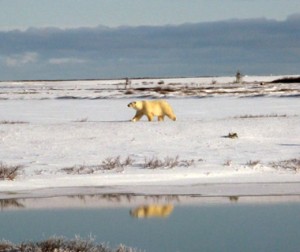Empty, snow-covered tundra stretches for hundreds of miles in every direction. An icy wind is blowing; a thickly batted quilt of cloud covers the sky. But I am trying mightily to jam open a frost-streaked window, brutal weather be damned. I want a clear view out of the rugged steel “Polar Rover” vehicle I’m in.
That’s because, atop a nearby ridge, two fully adult male polar bears—maybe 700 pounds apiece—have risen to their hind legs and clasped one another in a fierce embrace. As I struggle with the window sash, the bears grapple and strain, baring their curved incisors, muscling each other with their brawny shoulders. I know the bears are only posturing, testing each other in a mostly harmless display. Still, I want to be closer to all that power. I want to hear the growls and heaving breaths, the scrabbling of claws on frozen ground.
It’s why I’ve come, after all. I would travel to this bitterly cold, desolate expanse of subarctic Canada for only one reason: to get as near as I can to wild polar bears.
By the time I’ve jimmied the window open an inch, the two sparring bears are already exhausted. Panting heavily, each drops back to all fours with a hefty thud before backing away from the other. It’s then, as they pivot and amble off in separate directions, that I see the concave swoop of their bellies and realize how skinny they are.
For a moment, as if on cue, the bears both pause and raise their noses in the Rover’s direction, sniffing deeply. I imagine, excitedly, that they might be curious enough to approach. But then each turns away in retreat, and I realize the truth: they were probably just looking for food.
**
Like just about everyone growing up in the 1970s and ’80s, I was captivated by polar bears. The Life on Earth 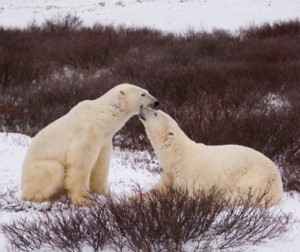 nature programs I watched as a child, and the photo essays I pored over in my parents’ issues of National Geographic, all painted the same majestic picture of the world’s largest land carnivores. The images of bears striding through pristine snowscapes, perched gracefully atop ice floes, and tussling with their cubs had given me a peculiar sense of security; even if I never got to see them, it was good to know these magnificent creatures were holding the fort at the lonely, frozen apex of the world.
nature programs I watched as a child, and the photo essays I pored over in my parents’ issues of National Geographic, all painted the same majestic picture of the world’s largest land carnivores. The images of bears striding through pristine snowscapes, perched gracefully atop ice floes, and tussling with their cubs had given me a peculiar sense of security; even if I never got to see them, it was good to know these magnificent creatures were holding the fort at the lonely, frozen apex of the world.
In recent years, though, the media portrait of polar bears has changed. Now televised footage of these regal animals is sure to be accompanied by a catalogue of sobering facts. Listed as threatened under the Endangered Species Act since 2007, Ursus maritimus, according to a U.S. Geological Survey report, may be close to extinct by 2050. The culprit, of course, is climate change—rising temperatures that have already caused dramatic recession of the Arctic sea ice where bears hunt and feed (nearly 23 percent, according to one study). In their more southerly habitats, polar bear populations over the past three decades have declined by more than 20 percent.
No child raised on David Attenborough could fail to agonize over these statistics. At least I couldn’t. One day last summer, after watching a particularly upsetting Animal Planet program about starving polar bear cubs, I moaned to my husband that soon the world’s polar bears would be gone.
“Not all of them,” he replied, consolingly. “I’m sure there will still be some in zoos.”
That settled it. Within a week, I’d researched and signed up for a three-day “Classic Polar Bear Tour” with Natural Habitat Adventures (NHA), an ecologically minded outfitter with a special affinity for endangered wildlife. I didn’t want to see polar bears in cement enclosures, lounging on painted “glaciers” and paddling in chlorinated pools. I wanted to see them where they belonged—while they still belonged somewhere.
**
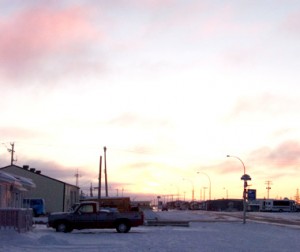 The town of Churchill, Manitoba (population, at last count, 926), sits 600 miles below the boundary of the Arctic Circle, a speck of civilization in an otherwise vast expanse of tundra, boreal forest, and icy sea. The community’s small grid of streets—home to a few modest hotels and restaurants, a handful of Eskimo galleries, a market and post office, and not much else—has an economy based almost completely around polar bear tourism. It’s all about the location: Churchill hugs the western edge of Hudson Bay—a saltwater basin twice the size of Texas that empties into both the North Atlantic (to the east) and the Arctic Ocean (to the north). Each winter, when air temperatures plunge to around -25 degrees, the bay begins to freeze, its rolling wavelets hardening to wadded hummocks of ice.
The town of Churchill, Manitoba (population, at last count, 926), sits 600 miles below the boundary of the Arctic Circle, a speck of civilization in an otherwise vast expanse of tundra, boreal forest, and icy sea. The community’s small grid of streets—home to a few modest hotels and restaurants, a handful of Eskimo galleries, a market and post office, and not much else—has an economy based almost completely around polar bear tourism. It’s all about the location: Churchill hugs the western edge of Hudson Bay—a saltwater basin twice the size of Texas that empties into both the North Atlantic (to the east) and the Arctic Ocean (to the north). Each winter, when air temperatures plunge to around -25 degrees, the bay begins to freeze, its rolling wavelets hardening to wadded hummocks of ice.
It’s this freeze, which happens around mid-November, that brings the polar bears—some 1,000 of them, collectively known as the Western Hudson Bay population. Typically, these bears spend the warm months between July and November denning (and subsisting without food) in regions far to the south. But once it starts getting cold, they migrate, often walking hundreds of miles, to the main gateway to their winter feeding grounds: the Hudson Bay coast.
By the time they reach Churchill, most bears have lost between 20 and 30 percent of their early-summer body weight. Depleted and famished, they are desperate to reach the remote colonies of ringed seals that are their main food source. But the seals can be more than 100 miles out from shore—too far to swim, even for the powerfully water-optimized bears. To claim their feast, they have to walk to it—which means they first have to wait for the bay to ice over.
Their wait has been growing longer. Warmer temperatures mean that sea ice now forms in Hudson Bay almost a month later than it did 30 years ago, and the shortened seal-hunting season has taken a toll on both the bears’ weight (which has dropped by 15 percent) and the number of new cubs born (since mother bears have to maintain a healthy weight of at least 450 pounds to reproduce).
This explains why, for about four weeks each year starting in mid-October, the world’s largest concentration of polar bears can be seen massing along the Churchill headlands overlooking the bay, sniffing the air for the scent of hardening ice. The sight is an enormous thrill for travelers, who come by the thousands to see the bears from the safety of naturalist-guided vehicles. (Along with Natural Habitat Adventures, which has run tours in Churchill since 1989, several other outfitters have bases here.) But timing such a visit right is crucial; once the sea ice forms, the bears can disappear from Churchill in a matter of hours.
**
“Is that one?” exclaimed one of my tour companions, a Coloradan geophysicist named Redge. Pointing 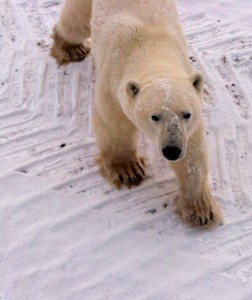 through the window of our lurching Polar Rover—a sort of hulking souped-up ice Hummer, with six-foot tractor tires for navigating rutted tundra—he indicated a distant buff-colored lump. In the next seat, our guide Eric gamely raised a pair of binoculars to assess the lump, then dropped them again immediately.
through the window of our lurching Polar Rover—a sort of hulking souped-up ice Hummer, with six-foot tractor tires for navigating rutted tundra—he indicated a distant buff-colored lump. In the next seat, our guide Eric gamely raised a pair of binoculars to assess the lump, then dropped them again immediately.
“Rock,” he announced. The dozen in our group let out a communal groan. Though it was only our first morning out, and we had two full days of bear scouting ahead of us, we’d been jouncing along for almost an hour and seen nothing but boulders—plus swaths of bear tracks, some of them tantalizingly fresh-looking.
“You guys, relax,” said Lisa, our Rover driver, who’d spent several seasons ferrying groups through the 3,200-square-mile Churchill Wildlife Management Area (the only part of the region sanctioned for tours). “You’re going to see bears.”
Within 10 minutes we realized she was right. First, as we approached the coastline, sticking to well-worn trails as conservancy law required, we began to see lumps-that-looked-like-rocks suddenly become animate (all of us shrieked as one far-off mound raised a distinctly bear-shaped snout to the wind). And once we had parked for the afternoon on a crest overlooking the slushy shore, we began to spot them all around us. There were several young males, crouched and dozing, spread among a thicket of willow shrubs not 20 feet away; further off, a mother and yearling cub kept cool by lolling on a frozen pond. Out our front windshield, we saw two large adults slowly approach each other and start playfully swiping each other with their snow-caked paws. The mock-skirmish escalated until they were wrestling and flailing on the ground like a pair of gargantuan puppies.
Late that afternoon, Redge’s wife, Linda, suddenly gasped, “Look!” A huge, splendid-looking bear had just hoisted itself from its resting place under a dwarf birch and was now shuffling, ponderous and pigeon-toed, toward our vehicle. Quietly, Eric motioned for us to follow him out the back door of the Rover and onto the elevated viewing deck.
By the time we had all zipped our parkas, grabbed our cameras, and gathered on the platform, the bear was already circling us. In hushed amazement we gazed at its thick, buttermilk-colored coat, its long scarred snout, its tiny folded ears. For an electrifying few moments, it paused beneath the deck, peering up at us through the steel mesh of the floor. The soft chuffing of its breath sent clouds drifting between our boots.
It was when the bear emerged out into the sunlight again that it happened. Turning abruptly, it effortlessly rose to its full height—nine, maybe 10 feet—planting two forepaws like furred bathmats against the Rover, just inches below where my mittens rested on the railing. The bear stretched its great shaggy head toward us, its wet nose quivering. Next to me, a Texan equity investor named Ed emitted a startled snort: the bear had fixed its black eyes right on him.
And then at once the encounter was over. Unceremoniously, the bear dropped to its forepaws and simply lumbered away.
That evening, over supper at a restaurant in Churchill, I listened as Ed recounted the experience to another group of diners.
“I swear,” he said. “That bear and I had a moment. For, like, 20 seconds, we locked eyes…it was like he was looking into my soul.”
Across the table, I chuckled. “Ed,” I chided. “Twenty? It might have been five.”
Unconvinced, Ed shook his head. “You can say what you want. All I know is when that bear looked at me, time stopped.”
I held my tongue. The truth was, Ed was right. For however long it had lasted, our confrontation with the bear had been hypnotic, like something we’d collectively hallucinated. I wouldn’t have been surprised afterward to find that hours had passed.
**
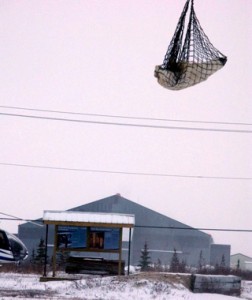 All of us had heard mention of Churchill’s “polar bear jail.” A hangar-shaped building on the outskirts of town, it was where “problem bears”—ones that’d been found prowling downtown streets or nosing into residents’ backyards—were taken after capture by the town’s polar bear patrol. Patrollers run a year-round, 24-hour hotline for residents who spot a bear in town; when called, they employ a variety of tactics (like firing noisemaking “crackers” from 12-gauge shotguns) to scare the bear off. If it’s persistent, though, they set a live trap, or shoot the bear with a tranquilizer dart, and take it to the holding facility before bringing it back to the tundra 35 or 40 miles away.
All of us had heard mention of Churchill’s “polar bear jail.” A hangar-shaped building on the outskirts of town, it was where “problem bears”—ones that’d been found prowling downtown streets or nosing into residents’ backyards—were taken after capture by the town’s polar bear patrol. Patrollers run a year-round, 24-hour hotline for residents who spot a bear in town; when called, they employ a variety of tactics (like firing noisemaking “crackers” from 12-gauge shotguns) to scare the bear off. If it’s persistent, though, they set a live trap, or shoot the bear with a tranquilizer dart, and take it to the holding facility before bringing it back to the tundra 35 or 40 miles away.
On the final morning of our trip, Eric told us we were in for a rare surprise. The bear patrol, he’d learned, was scheduled to airlift a bear via helicopter that very day; though that was seldom seen by tour groups, we’d be stopping by the “jail” to watch the event.
“There are quite a few bears in there right now,” Eric said, referring to the holding facility. “Once they’ve been tagged and had their vitals logged, the patrollers try to get them back out as soon as possible.”
“How many is ‘quite a few’?” I asked, figuring maybe a half-dozen bears were brazen enough to have ventured downtown in a single season.
“Twenty,” Eric said, solemnly.
Later, outside the holding facility, we stood cordoned in a parking area far from the building. It was bitterly cold. The temperature when we’d woken up that morning had been -16 degrees; now a brutal gust had kicked up, numbing our exposed cheeks and blurring our eyes with tears.
By the time the hangar doors opened, it had started to snow. Through the driving flakes, we watched as a jeep with a flatbed trailer emerged. Lying atop it was a colossal mass the color of dirty cream: the tranquilized bear, sprawled on a stretcher. Working quickly, a cadre of patrollers, like pallbearers, lowered the bear to rest atop a net spread on the ground; once it was fastened, a whirring helicopter that had been hovering overhead hooked the net with a long length of rope. Then, its cargo secured, the helicopter lifted.
For a moment we all gaped at the surreal sight of the bear, curled supine in the net, hoisted high above our heads like a bag of laundry. Then the copter pivoted and began to pull away, heading north toward the far-off tundra where it would make its deposit. The next day, it would make another, and then another.
**
Natural Habitat Adventures’ Classic Polar Bear Adventure (from $4,995 per person) includes all meals, 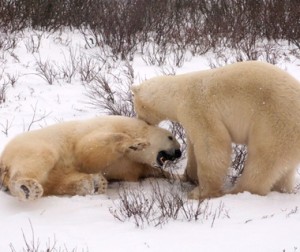 accommodations in Churchill, stopover accommodations in Winnipeg, and flights between Winnipeg and Churchill. NHA also offers more specialized polar bear trips for photographers and those wanting to stay in its unique Tundra Lodge.
accommodations in Churchill, stopover accommodations in Winnipeg, and flights between Winnipeg and Churchill. NHA also offers more specialized polar bear trips for photographers and those wanting to stay in its unique Tundra Lodge.
The Tundra Lodge
Travelers who want an especially close vantage point for polar bear viewing (and don’t mind reserving up to a year in advance) can book one of the 28 berths in NHA’s distinctive Tundra Lodge—a “train” of connected sleeping, dining, and lounge cars on wheels that is parked right on the tundra of the Churchill Wildlife Management Area. Guests sleep in tiny but private sleeper-cabin quarters, share bathrooms, and take all their meals in the lodge’s fully equipped kitchen-and-dining car. The trade-off: they get to be surrounded, around the clock and on all sides, by bears. Tundra Lodge Adventures cost more (from $6,695), but are undoubtedly worth it.


